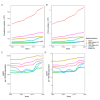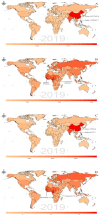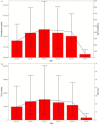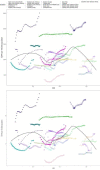Global, regional and national burden of male infertility in 204 countries and territories between 1990 and 2019: an analysis of global burden of disease study
- PMID: 37940907
- PMCID: PMC10631182
- DOI: 10.1186/s12889-023-16793-3
Global, regional and national burden of male infertility in 204 countries and territories between 1990 and 2019: an analysis of global burden of disease study
Abstract
Background: Many countries and regions have experienced male fertility problems due to various influencing factors, especially in less developed countries. Unlike female infertility, male infertility receives insufficient attention. Understanding the changing patterns of male infertility in the world, different regions and different countries is crucial for assessing the global male fertility and reproductive health.
Methods: We obtained data on prevalence, years of life lived with disability (YLD), age-standardized rates of prevalence (ASPR) and age-standardized YLD rate (ASYR) from the Global Burden of Disease Study 2019. We analyzed the burden of male infertility at all levels, including global, regional, national, age stratification and Socio-demographic Index (SDI).
Results: In 2019, the global prevalence of male infertility was estimated to be 56,530.4 thousand (95% UI: 31,861.5-90,211.7), reflecting a substantial 76.9% increase since 1990. Furthermore, the global ASPR stood at 1,402.98 (95% UI: 792.24-2,242.45) per 100,000 population in 2019, representing a 19% increase compared to 1990. The regions with the highest ASPR and ASYR for male infertility in 2019 were Western Sub-Saharan Africa, Eastern Europe, and East Asia. Notably, the prevalence and YLD related to male infertility peaked in the 30-34 year age group worldwide. Additionally, the burden of male infertility in the High-middle SDI and Middle SDI regions exceeded the global average in terms of both ASPR and ASYR.
Conclusion: The global burden of male infertility has exhibited a steady increase from 1990 to 2019, as evidenced by the rising trends in ASPR and ASYR, particularly in the High-middle and Middle SDI regions. Notably, the burden of male infertility in these regions far exceeds the global average. Additionally, since 2010, there has been a notable upward trend in the burden of male infertility in Low and Middle-low SDI regions. Given these findings, it is imperative to prioritize efforts aimed at improving male fertility and reproductive health.
Keywords: Global burden of disease; Male infertility; Socio-demographic index; Years lived with disability.
© 2023. The Author(s).
Conflict of interest statement
The authors declare no competing interests.
Figures




Similar articles
-
Global, regional, and national burden of infertility attributable to PCOS, 1990-2019.Hum Reprod. 2024 Jan 5;39(1):108-118. doi: 10.1093/humrep/dead241. Hum Reprod. 2024. PMID: 38011904
-
Global incidence, prevalence, and disability of vertebral fractures: a systematic analysis of the global burden of disease study 2019.Spine J. 2022 May;22(5):857-868. doi: 10.1016/j.spinee.2021.12.007. Epub 2021 Dec 11. Spine J. 2022. PMID: 34906740
-
Epidemiological characteristics of infertility, 1990-2021, and 15-year forecasts: an analysis based on the global burden of disease study 2021.Reprod Health. 2025 Feb 19;22(1):26. doi: 10.1186/s12978-025-01966-7. Reprod Health. 2025. PMID: 39972325 Free PMC article.
-
Burden of female infertility in 204 countries and territories, 1990-2021: results from the Global Burden of Disease Study 2021.J Psychosom Obstet Gynaecol. 2025 Dec;46(1):2459618. doi: 10.1080/0167482X.2025.2459618. Epub 2025 Feb 12. J Psychosom Obstet Gynaecol. 2025. PMID: 39936646 Review.
-
Spinal cord injury: global burden from 1990 to 2019 and projections up to 2030 using Bayesian age-period-cohort analysis.Front Neurol. 2023 Dec 5;14:1304153. doi: 10.3389/fneur.2023.1304153. eCollection 2023. Front Neurol. 2023. PMID: 38116113 Free PMC article. Review.
Cited by
-
Exploring the evolving function of soluble intercellular adhesion molecule-1 in junction dynamics during spermatogenesis.Front Endocrinol (Lausanne). 2024 Jan 8;14:1281812. doi: 10.3389/fendo.2023.1281812. eCollection 2023. Front Endocrinol (Lausanne). 2024. PMID: 38260159 Free PMC article. Review.
-
Histone lysine methyltransferases and their specific methylation marks show significant changes in mouse testes from young to older ages.Biogerontology. 2025 Jan 20;26(1):42. doi: 10.1007/s10522-025-10187-1. Biogerontology. 2025. PMID: 39832035 Free PMC article.
-
The Impact of Physical Exercise on Male Fertility Through Its Association with Various Processes and Aspects of Human Biology.J Clin Med. 2025 May 14;14(10):3442. doi: 10.3390/jcm14103442. J Clin Med. 2025. PMID: 40429435 Free PMC article. Review.
-
Impact of Oxidative Stress on Sperm Quality in Oligozoospermia and Normozoospermia Males Without Obvious Causes of Infertility.J Clin Med. 2024 Nov 26;13(23):7158. doi: 10.3390/jcm13237158. J Clin Med. 2024. PMID: 39685616 Free PMC article.
-
Joint and individual associations between multiple vitamins and sperm quality in adult men.Front Nutr. 2025 Mar 28;12:1534309. doi: 10.3389/fnut.2025.1534309. eCollection 2025. Front Nutr. 2025. PMID: 40225346 Free PMC article.
References
-
- Vollset SE, Goren E, Yuan CW, Cao J, Smith AE, Hsiao T, et al. Fertility, mortality, migration, and population scenarios for 195 countries and territories from 2017 to 2100: a forecasting analysis for the global burden of Disease Study. Lancet. 2020;396(10258):1285–306. doi: 10.1016/S0140-6736(20)30677-2. - DOI - PMC - PubMed
MeSH terms
LinkOut - more resources
Full Text Sources
Medical

